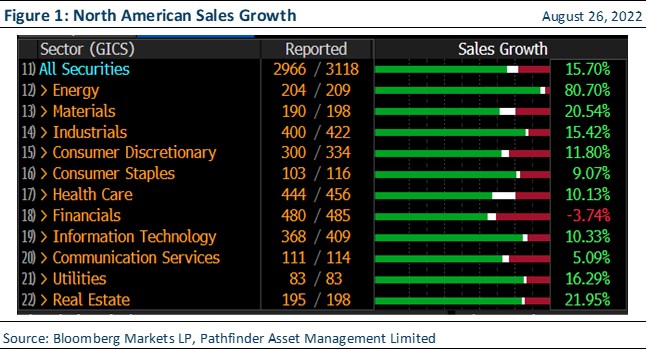Q2 Earnings Season Complete
As regular readers of the Investment Outlook know, our writing follows the calendar of quarterly earnings reports. The companies that we invest in report financial data and management commentary on a regular basis, which is colloquially called “earnings season”. This is an important part of our investment process because we are able to check-in on the progress of the companies that we own, as well as management’s expectations for the future of their business operations. Internally, we informally declare the “end-of-earnings season” when the results of the Canadian banks are published. The quarter “ended” this week with bank earnings. Regular readers will recognize the aggregate sales data for North American companies noted in Figure 1. We have mentioned before that we prefer to review aggregate sales data as it is harder to manipulate than earnings. For a large group of companies, we feel this is a better way to take the temperature of how the North American economy is performing. We also focus on “all listed companies” in North America, rather than a widely used index, like the S&P 5oo for example, because we find the large global companies in those types of indices can skew a significant portion of what would be “Main Street”. This could cause us to draw incorrect conclusions from the data.
- So far, 95% of 3,118 of companies have reported their results this quarter and aggregate sales have grown double digit again (15.7%). Energy remains the biggest contributor, which makes sense given the recent price of oil. Sales on a broad base were generally strong with Financials being the only negative performer on the quarter. This now breaks the trend of all sectors posting positive sales growth over the last year.

- We don’t normally look at surprise data, but this quarter, we have anecdotally noticed that earnings results have tended to beat estimates that have been provided by the stock brokerage firms. This is interesting given the relatively negative view from the financial press. Indeed, on average this quarter, companies beat sales estimates by 3.5% and earnings outperformed by 2.0%. We do note that margins have been compressed due to inflationary impacts but in the end, they have fallen less than expected.
“This means that” the economy continues to post topline sales growth when compared to last year, which is good. We do need to keep in mind that we are still in a recovery period, so we are coming off from a lower base. Another caution is that there is an inflationary component to the numbers, given that prices in general have risen.
National Instrument 31-103 requires registered firms to disclose information that a reasonable investor would expect to know, including any material conflicts with the firm or its representatives. Doug Johnson and/or Pathfinder Asset Management Limited are an insider of companies periodically mentioned in this report. Please visit www.paml.ca for full disclosures.
*All returns are time weighted and net of investment management fees. Returns from the Pathfinder Partners’ Fund and Partners’ Real Return Plus Fund are presented based on the masters series of each fund. The Pathfinder Core: Equity Portfolio and The Pathfinder Core: High Income Portfolio are live accounts. These are actual accounts owned by the Pathfinder Chairman (Equity) and client (High Income) which contain no legacy positions, cash flows or other Pathfinder investment mandates or products. Monthly inception dates for each fund and portfolio are as follows: Pathfinder Core: Equity Portfolio (January 2011), Pathfinder Core: High Income Portfolio (October 2012) Partners’ Fund (April 2011), Partners’ Real Return Plus Fund (April, 2013), and Partners’ Core Plus Fund (November 2014).
Pathfinder Asset Management Limited (PAML) and its affiliates may collectively beneficially own in excess of 10% of one or more classes of the issued and outstanding equity securities mentioned in this newsletter. This publication is intended only to convey information. It is not to be construed as an investment guide or as an offer or solicitation of an offer to buy or sell any of the securities mentioned in it. The author has taken all usual and reasonable precautions to determine that the information contained in this publication has been obtained from sources believed to be reliable and that the procedures used to summarize and analyze such information are based on approved practices and principles in the investment industry. However, the market forces underlying investment value are subject to sudden and dramatic changes and data availability varies from one moment to the next. Consequently, neither the author nor PAML can make any warranty as to the accuracy or completeness of information, analysis or views contained in this publication or their usefulness or suitability in any particular circumstance. You should not undertake any investment or portfolio assessment or other transaction on the basis of this publication, but should first consult your portfolio manager, who can assess all relevant particulars of any proposed investment or transaction. PAML and the author accept no liability of any kind whatsoever or any damages or losses incurred by you as a result of reliance upon or use of this publication.